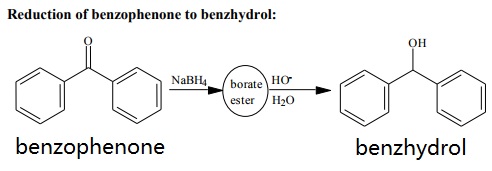Benzhydrylalkohol Chemische Eigenschaften,Einsatz,Produktion Methoden
Synthese
In eine Lösung von 1.822 g (10 mmol) Benzophenon in 8 ml Methanol gibt man unter Rühren mittels eines Magnetrührers portionsweise 0.4 g (10 mmol) Natriumborhydrid hinzu. Da das Natriumborhydrid hygroskopisch ist, wird es in einem verschließbaren trockenen Gefäß eingewogen. Danach rührt man 45 Minuten weiter und gibt zum Schluss noch 10-20 ml Wasser hinzu. Das Reaktionsgemisch wird im Scheidetrichter mit Petrolether dreimal ausgeschüttelt. Die untere wässrige Phase wird in ein Becherglas abgelassen, während die Etherphase in einen Erlenmeyerkolben überführt wird. Die wässrige Phase wird erneut im Scheidetrichter mit Petrolether ausgeschüttelt. Danach wird das Petroleumbenzin aus dem Erlenmeyerkolben wieder in den Scheidetrichter gegeben und mit Wasser ausgeschüttelt. Anschließend lässt man die Etherphase in einem Erlenmeyerkolben ab und trocknet sie mit Natriumsulfat 15-30 Minuten unter gelegentlichen schütteln. Zur besseren Trocknung kann man auch mit einem Magnetrührer und dessen Rührstäbchen rühren. Das Trockenmittel (Natriumsulfat) wird abfiltriert (Watte oder Schwarzbandfilter), am Verdampfer der Petrolether entfernt und das Produkt mit ca. 30 ml Petrolether umkristallisiert, abgesaugt und im Vakuumtrockenschrank getrocknet. Ausbeute: 1.41 g, entspricht 76.5% der Theorie, Smp. 65.3 ℃. Zur Reinheitsbestimmung wird der Schmelzpunkt bestimmt (65-67 ℃) und eine Dünnschichtchromatographie (DC) durchgeführt. Als Laufmittel wird ein Gemisch aus Petrolether und Essigsäureethylester im Verhältnis 5:1 verwendet. Kieselgel KG60 als DC-Platte, Detektion bei 254 nm (UV-Lampe). Rf � Wert liegt bei 0.87.

R-Sätze Betriebsanweisung:
R36/37/38:Reizt die Augen, die Atmungsorgane und die Haut.
S-Sätze Betriebsanweisung:
S26:Bei Berührung mit den Augen sofort gründlich mit Wasser abspülen und Arzt konsultieren.
S36:DE: Bei der Arbeit geeignete Schutzkleidung tragen.
S24/25:Berührung mit den Augen und der Haut vermeiden.
Chemische Eigenschaften
off-white powder or White or colorless crystals. M.P. 69℃. B.p. 281℃. Practically insoluble in water, soluble in alcohol, miscible with oils. The crystals have a very faint musty-rosy
odor, somewhat similar to that of Benzophenonc and Trichloromethyl phenyl carbinyl
acetate.
Verwenden
- Benzhydrols are industrially important compounds. On oxidation Benzhydrols yields Benzophenone, which are useful synthones for fullerenes, bioactive oxygen heterocycles, dyes and medicines. Various Cr (VI) and other oxidizing agents are used for oxidizing benzhydrol.
- Benzhydrol is widely used as intermediates in pharmaceuticals (including antihistamines), agrochemicals, perfumes and other organic compounds. It is used as a fixative in the perfume industry. It is involved in polymerization reaction as a terminating group. It is used as precursor to prepare modafinil, benztropine and diphehydramine.
- Intermediate in the preparation of Modafinil (M482500).
Reaktionen
Benzhydrol is oxidized to benzophenone, by sodium hypochlorite (commonly known as bleach) in the presence of a phase-transfer catalyst.
Synthesis: In a 20-mL green capped vial, place 1.5 mL of ethyl acetate, 100 mg (0.54 mmol) of benzhydrol and a few drops of methyltricaprylammonium chloride solution (Stark's catalyst or tricaprylmethylammonium chloride). Add a half-inch magnetic stirring bar, and stir until all reagents are dissolved. Cool the solution in an ice bath and add 2 mL of 5% NaOCl (aq) (bleach) dropwise using a 2.5- mL syringe. After the addition of the hypochlorite is complete, allow the reaction to stir for five minutes in the ice-water bath and then stir for a period of one hour at room temperature.

Reduction of benzophenone to benzhydrol.
4MPDC (4-Methyl pyridinium di chromate) is used as oxidizing agent to oxidize benzhydrol. PDC is a mild and selective oxidizing agent and is soluble in water and many organic solvents. Therefore, advantage over inorganic dichromate.
Allgemeine Beschreibung
Pharmaceutical secondary standards for application in quality control provide pharma laboratories and manufacturers with a convenient and cost-effective alternative to the preparation of in-house working standards
läuterung methode
Crystallise benzhydrol from hot H2O or pet ether (b 60-70o), pet ether containing a little *benzene, from CCl4, or EtOH (1mL/g). An additional purification step includes passage of a *benzene solution through an activated alumina column. It sublimes in a vacuum. Also recrystallise it three times from MeOH/H2O [Naguib J Am Chem Soc 108 128 1986]. [Beilstein 6 IV 4648.]
Benzhydrylalkohol Upstream-Materialien And Downstream Produkte
Upstream-Materialien
Downstream Produkte

